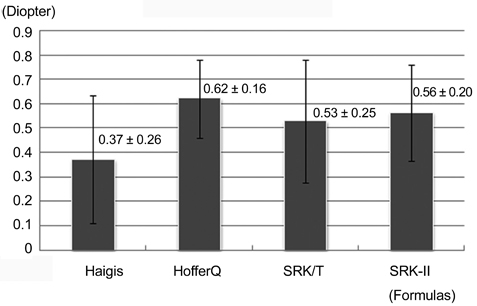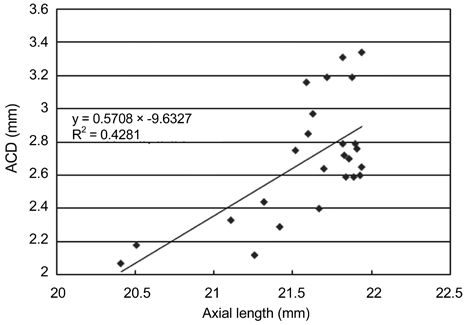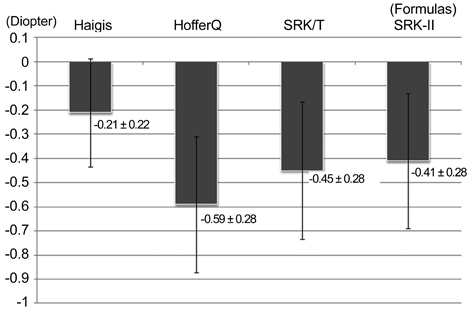Korean J Ophthalmol.
2011 Jun;25(3):151-155. 10.3341/kjo.2011.25.3.151.
Intraocular Lens Power Calculation Using IOLMaster and Various Formulas in Short Eyes
- Affiliations
-
- 1Department of Ophthalmology, Seoul National University College of Medicine, Seoul, Korea. lsm10003@chollian.net
- 2Department of Ophthalmology, Seoul National University Boramae Hospital, Seoul, Korea.
- 3Department of Ophthalmology, The Armed Forces Capital Hospital, Seongnam, Korea.
- 4Department of Ophthalmology, Seoul National University Bundang Hospital, Seongnam, Korea.
- KMID: 1010020
- DOI: http://doi.org/10.3341/kjo.2011.25.3.151
Abstract
- PURPOSE
To evaluate the predictability of intraocular lens (IOL) power calculations using the IOLMaster and four different IOL power calculation formulas (Haigis, Hoffer Q, SRK II, and SRK/T) for cataract surgery in eyes with a short axial length (AL).
METHODS
The present study was a retrospective comparative analysis which included 25 eyes with an AL shorter than 22.0 mm that underwent uneventful phacoemulsification with IOL implantation from July 2007 to December 2008 at Seoul National University Boramae Hospital. Preoperative AL and keratometric power were measured by the IOLMaster, and power of the implanted IOL was determined using Haigis, Hoffer Q, SRK II, and SRK/T formulas. Postoperative refractive errors two months after surgery were measured using automatic refracto-keratometry (Nidek) and were compared with the predicted postoperative power. The mean absolute error (MAE) was defined as the average of the absolute value of the difference between actual and predicted spherical equivalences of postoperative refractive error.
RESULTS
The MAE was smallest with the Haigis formula (0.37 +/- 0.26 diopter [D]), followed by those of SRK/T (0.53 +/- 0.25 D), SRK II (0.56 +/- 0.20 D), and Hoffer Q (0.62 +/- 0.16 D) in 25 eyes with an AL shorter than 22.0 mm. The proportion with an absolute error (AE) of less than 1 D was greatest in the Haigis formula (96%), followed by those in the SRK II (88%), SRK-T (84%), and Hoffer Q (80%).
CONCLUSIONS
The MAE was less than 0.7 D and the proportion of AE less than 1 D was more than 80% in all formulas. The IOL power calculation using the Haigis formula showed the best results for postoperative power prediction in short eyes.
MeSH Terms
Figure
Cited by 1 articles
-
Analysis of Factors that Influence on Accuracy of Intraocular Lens Power Calculation
Bo Hyuck Kim, Won Ryang Wee, Mee Kum Kim
J Korean Ophthalmol Soc. 2014;55(2):173-181. doi: 10.3341/jkos.2014.55.2.173.
Reference
-
1. Kershner RM. Sutureless one-handed intercapsular phacoemulsification. The keyhole technique. J Cataract Refract Surg. 1991. 17:Suppl. 719–725.2. Olsen T, Dam-Johansen M, Bek T, Hjortdal JO. Evaluating surgically induced astigmatism by Fourier analysis of corneal topography data. J Cataract Refract Surg. 1996. 22:318–323.3. Olson RJ, Crandall AS. Prospective randomized comparison of phacoemulsification cataract surgery with a 3.2-mm vs a 5.5-mm sutureless incision. Am J Ophthalmol. 1998. 125:612–620.4. Kohnen T. Multifocal IOL technology: a successful step on the journey toward presbyopia treatment. J Cataract Refract Surg. 2008. 34:2005.5. Lee AC, Qazi MA, Pepose JS. Biometry and intraocular lens power calculation. Curr Opin Ophthalmol. 2008. 19:13–17.6. Drexler W, Findl O, Menapace R, et al. Partial coherence interferometry: a novel approach to biometry in cataract surgery. Am J Ophthalmol. 1998. 126:524–534.7. Holladay JT. Refractive power calculations for intraocular lenses in the phakic eye. Am J Ophthalmol. 1993. 116:63–66.8. Olsen T. Improved accuracy of intraocular lens power calculation with the Zeiss IOLMaster. Acta Ophthalmol Scand. 2007. 85:84–87.9. Wang JK, Hu CY, Chang SW. Intraocular lens power calculation using the IOLMaster and various formulas in eyes with long axial length. J Cataract Refract Surg. 2008. 34:262–267.10. MacLaren RE, Natkunarajah M, Riaz Y, et al. Biometry and formula accuracy with intraocular lenses used for cataract surgery in extreme hyperopia. Am J Ophthalmol. 2007. 143:920–931.11. Findl O, Drexler W, Menapace R, et al. High precision biometry of pseudophakic eyes using partial coherence interferometry. J Cataract Refract Surg. 1998. 24:1087–1093.12. Schachar RA, Levy NS, Bonney RC. Accuracy of intraocular lens powers calculated from A-scan biometry with the Echo-Oculometer. Ophthalmic Surg. 1980. 11:856–858.13. Connors R 3rd, Boseman P 3rd, Olson RJ. Accuracy and reproducibility of biometry using partial coherence interferometry. J Cataract Refract Surg. 2002. 28:235–238.14. Gavin EA, Hammond CJ. Intraocular lens power calculation in short eyes. Eye (Lond). 2008. 22:935–938.15. Terzi E, Wang L, Kohnen T. Accuracy of modern intraocular lens power calculation formulas in refractive lens exchange for high myopia and high hyperopia. J Cataract Refract Surg. 2009. 35:1181–1189.16. Chen MJ, Liu YT, Tsai CC, et al. Relationship between central corneal thickness, refractive error, corneal curvature, anterior chamber depth and axial length. J Chin Med Assoc. 2009. 72:133–137.17. Olsen T. Calculation of intraocular lens power: a review. Acta Ophthalmol Scand. 2007. 85:472–485.18. Kim SM, Choi J, Choi S. Refractive predictability of partial coherence interferometry and factors that can affect It. Korean J Ophthalmol. 2009. 23:6–12.
- Full Text Links
- Actions
-
Cited
- CITED
-
- Close
- Share
- Similar articles
-
- Comparison of Formulas for Intraocular Lens Power Calculation Installed in a Partial Coherence Interferometer
- Comparison of the SRK and SRKII Formulas with Revision of Constant A in Intraocular Lens Power Calculation
- Evaluation for the Accuracy of the SRK/T Formula in PCL Implanted Patients(I)
- Accuracy of Intraocular Lens Power Calculations According to Corneal Curvature in Short Eyes
- Comparative Efficacy of the New Optical Biometer on Intraocular Lens Power Calculation (AL-Scan versus IOLMaster)





